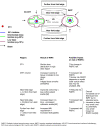Second primary cancers after radiation for prostate cancer: a review of data from planning studies
- PMID: 23835163
- PMCID: PMC3724744
- DOI: 10.1186/1748-717X-8-172
Second primary cancers after radiation for prostate cancer: a review of data from planning studies
Abstract
A review of planning studies was undertaken to evaluate estimated risks of radiation induced second primary cancers (RISPC) associated with different prostate radiotherapy techniques for localised prostate cancer. A total of 83 publications were identified which employed a variety of methods to estimate RISPC risk. Of these, the 16 planning studies which specifically addressed absolute or relative second cancer risk using dose-response models were selected for inclusion within this review. There are uncertainties and limitations related to all the different methods for estimating RISPC risk. Whether or not dose models include the effects of the primary radiation beam, as well as out-of-field regions, influences estimated risks. Regarding the impact of IMRT compared to 3D-CRT, at equivalent energies, several studies suggest an increase in risk related to increased leakage contributing to out-of-field RISPC risk, although in absolute terms this increase in risk may be very small. IMRT also results in increased low dose normal tissue irradiation, but the extent to which this has been estimated to contribute to RISPC risk is variable, and may also be very small. IMRT is often delivered using 6MV photons while conventional radiotherapy often requires higher energies to achieve adequate tissue penetration, and so comparisons between IMRT and older techniques should not be restricted to equivalent energies. Proton and brachytherapy planning studies suggest very low RISPC risks associated with these techniques. Until there is sufficient clinical evidence regarding RISPC risks associated with modern irradiation techniques, the data produced from planning studies is relevant when considering which patients to irradiate, and which technique to employ.
Figures
References
-
- EUROCARE. Survival of cancer patients in europe. The EUROCARE-4 study. Survival analysis 1995–1999. 2009. [cited 2012 15.03.2012]; Available from: http://www.eurocare.it/Portals/0/CDEU4/Index.htm.
-
- De Gonzalez AB, Curtis RE, Kry SF, Gilbert E, Lamart S, Berg CD, Stovall M, Ron E. Proportion of second cancers attributable to radiotherapy treatment in adults: a cohort study in the US SEER cancer registries. Lancet Oncol. 2011;12(4):353–360. doi: 10.1016/S1470-2045(11)70061-4. - DOI - PMC - PubMed
Publication types
MeSH terms
LinkOut - more resources
Full Text Sources
Other Literature Sources
Medical
Research Materials



